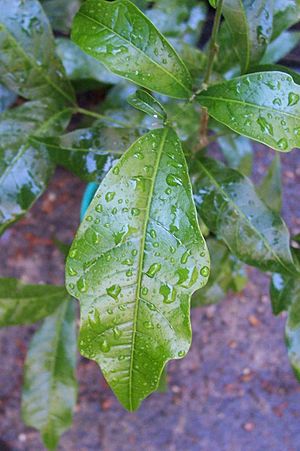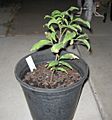Diploglottis campbellii facts for kids
Quick facts for kids Diploglottis campbellii |
|
|---|---|
 |
|
| Diploglottis campbellii juvenile leaf | |
| Conservation status | |
| Scientific classification | |
| Genus: |
Diploglottis
|
| Species: |
campbellii
|
The Diploglottis campbellii is a special rainforest tree. It grows in northern New South Wales and southeastern Queensland, Australia. People often call it the small-leaved tamarind. This tree can grow very tall, up to 30 metres!
Sadly, the small-leaved tamarind is quite rare and threatened in the wild. You can only find a few of these trees in certain spots. But don't worry, you can easily find them in plant nurseries. This helps make sure more of these amazing trees can grow.
The young leaves of this tree are soft and a bit hairy. As they get older, they become smooth. Its trunk is grey-brown, and the bark can have green, orange, or brown patches. The leaves are quite long, about 10 to 35 centimetres. Each leaf has smaller parts called leaflets, which are 4 to 8 centimetres long. The top of the leaves is shiny, while the bottom is a duller, paler colour.
Contents
Flowers and Fruit of the Small-leaved Tamarind
The small-leaved tamarind produces small, creamy-brown flowers. These flowers grow in clusters up to 15 centimetres long. After the flowers, the tree grows interesting fruit.
The fruit usually has two parts, or "lobes." Sometimes it can have one or three lobes. Each lobe holds a single seed inside. The fruit is smooth and can be red, though sometimes it's yellow. It ripens around February to April.
What are the Uses of Small-leaved Tamarind?
The fruit of the small-leaved tamarind is edible, meaning you can eat it! It has a unique, slightly tart flavour. People use it to make delicious sauces and jams. For a long time, it was hard to find enough fruit because the tree was so rare.
But now, more and more small-leaved tamarind trees are being planted. This means there's more fruit available for food. It also helps protect this special tree species from disappearing.
Growing Small-leaved Tamarind Trees
This tree is also great for planting in gardens and parks. It's used in amenity horticulture, which means growing plants for beauty and enjoyment. It's also part of bushfood plantings, which are native Australian foods. You can see many of these trees planted in the city of Lismore.
Images for kids
-
Unusual yellow fruit of Diploglottis campbellii and orange fruit of the rare Hicksbeachia pinnatifolia
External sources
- Information obtained at Tafe Grovely Campus
See also
 In Spanish: Diploglottis campbellii para niños
In Spanish: Diploglottis campbellii para niños




